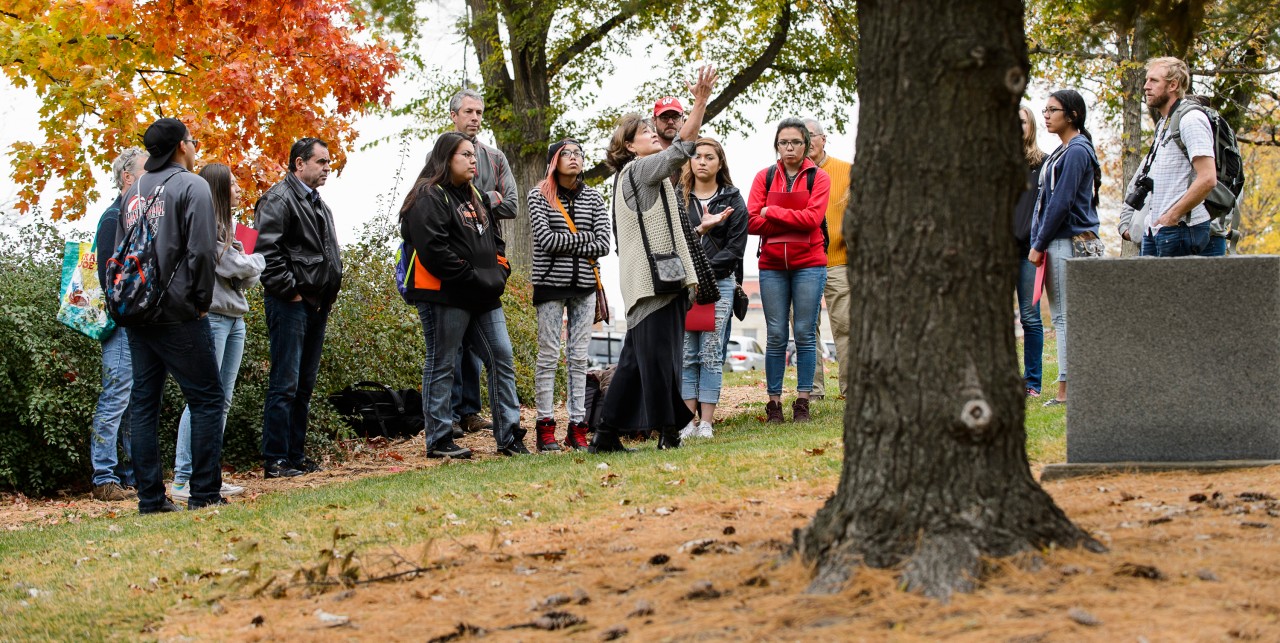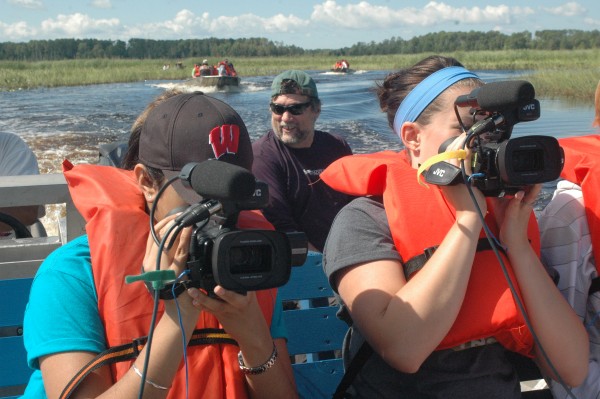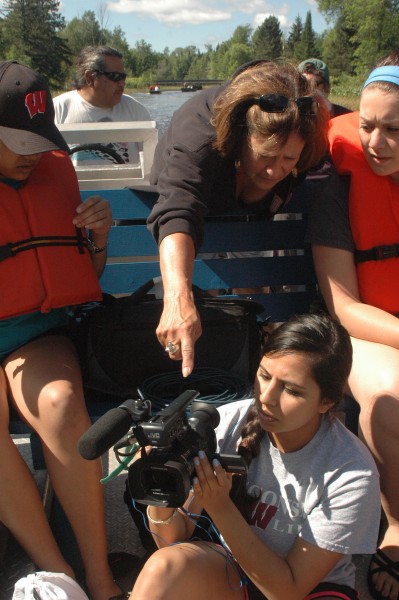Age-Old Traditions, New Media

There is no better place to begin this story than on an August morning in the remote reaches of the Bad River Ojibwe Reservation, afloat on Lake Superior’s shining Chequamegon Bay beneath an expansive, cloud-filled sky.
Several flat-bottomed boats are lined up gunwale-to-gunwale, bobbing in the gentle waves. They’re filled with students—a mix of UW–Madison undergraduates and tribal youth—on a field project run through UW–Madison’s Global Health Institute. They are listening to Dana Jackson and Edith Leoso, Bad River tribal members and elders, talk about wild rice and the windswept, watery landscape around them, the sloughs and the tamarack stands, the distant islands and the shimmering headlands.

It is all ancestral home to the Ojibwe, and Jackson and Leoso bring it to life with their words. They tell the Ojibwe creation story of how their tribal forebears came to the land so many years ago from the east, seeking, as they had been told in visions, a place where “the food grows on top of the water.” They speak of the chiefs who signed treaties to protect this homeland and of the warriors who fought to protect it and of the threats that come with modern times.
The students, armed with video cameras and recorders, soak it all up. The land seems to take on new depth and meaning, peopled now with the ghosts and the place names and shrouded in the mystery and the magic of the old stories.
It’s an ideal classroom for the CALS professor who is the guiding hand behind this floating, open-air lecture session.
Patty Loew, a professor of life sciences communication, has brought these students here to share with them the lives and the culture of a people she knows well.
Loew is a tribal member of the Bad River Ojibwe. She can trace her family back to ancestors who were among the tribal leaders signing the tribe’s historic treaties in the 1800s. When she looks out upon the waters of Lake Superior and the winding sloughs of the reservation, she sees her own family’s history. These places are as special to her as to any other member of the Bad River community.

Two years ago, in a column in the Wisconsin State Journal about the importance of this place to the Ojibwe, Loew wrote, “You won’t see any stained glass or church spires in the Bad River or Kakagon Sloughs, but those wetlands are as holy to us as any temple or cathedral.”
A noted television journalist and the author of several acclaimed books on Wisconsin’s Native Americans as well as an accomplished scholar, Loew could easily be resting on her many successes.
Instead, she is deeply involved in a number of teaching and media projects that are not only bringing the stories of Wisconsin’s Native Americans to life, but also are providing new ways for those stories to be shared by tribal members themselves. Since 2007, she has led efforts to teach tribal teenagers digital storytelling and technology skills. Working with colleagues as well as tribal leaders, she has helped young people create documentaries sharing Native American issues and culture. In a 2012 project, for example, eight St. Croix Ojibwe students created a tribal history told through the life stories of five St. Croix elders.
In this work Loew has also partnered with the UW–Madison Global Health Institute. She’s currently in the midst of a project—the one that has us floating on Chequamegon Bay—in which global health students from a wide range of majors work alongside tribal youth to bring the power of digital media to bear on reservation health issues such as nutrition and childhood obesity. The Bad River reservation has some of the highest diabetes and cardiovascular disease rates in the United States, according to a 2008 Wisconsin Nutrition and Growth Study.
Loew’s projects can already boast some impressive successes. In 2013, three 14-year-old Bad River participants in her tribal youth media workshops produced a documentary, Protect Our Future, that detailed the potential environmental threats posed by a proposed iron mine in the Penokee Range above the Bad River reservation.
The video was an award-winning hit. It played to large audiences at film festivals throughout the Great Lakes region and was screened at the Arizona State University Human Rights Festival. The teens were on hand to introduce their film, which they also shared at the nearby Salt River Tribal High School.
The project followed a unique blueprint developed by Loew that melds traditional knowledge from tribal elders and leaders with the use of digital media skills now being deployed by tribal youth.
It is, in effect, an artful and sensitive blending of the old and new. Loew, not one to think small, says she sees the work in the context of a larger and more powerful dream. Oblivious to the breeze and splashing water from Lake Superior, she speaks from her seat in one of the boats as it motors through the reservation’s famed Kakagon Sloughs. In between her answers to questions, she patiently works with students as they learn how to use video cameras. She helps one of them frame a shot and assists another who is figuring out how to program a video card.
“My ultimate goal,” Loew says as she works, “is to help Bad River become the media center for Indian Country. We want to combine really strong media skills with a really strong sense of culture.”
Continue reading this story in the Spring 2016 issue of Grow magazine.

